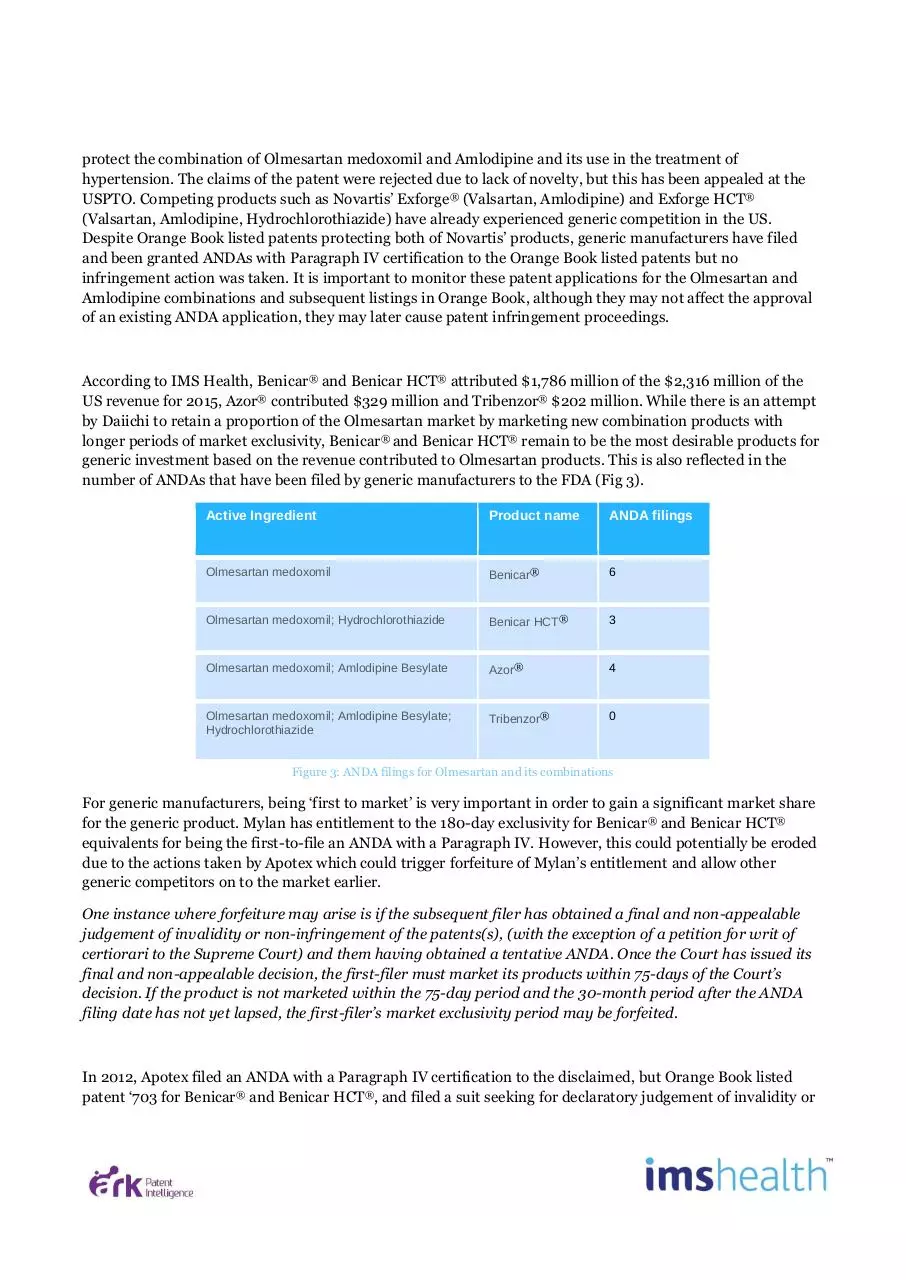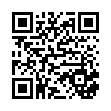DIF Olmesartanv4 (PDF)
File information
Author: IMS Health
This PDF 1.5 document has been generated by Microsoft® Word 2013, and has been sent on pdf-archive.com on 03/05/2016 at 14:30, from IP address 123.243.x.x.
The current document download page has been viewed 828 times.
File size: 284.78 KB (4 pages).
Privacy: public file




File preview
Drug In Focus: Olmesartan
April 2016
Daiichi Sankyo’s Olmesartan franchise (Benicar®, Benicar HCT®, Azor® and Tribenzor®) is set to
lose patent protection in Oct 2016 due to expiry of one of its strongest patents ‘US5616599’. This
opens up a market worth ~US$2.3 billion to generic competition. Daiichi’s life cycle management
strategy to combine Olmesartan with other antihypertensive drugs will protect some of the revenues,
but generics of Benicar® and Benicar HCT® are expected to erode much of the revenue share.
General information
Developed by Sankyo (now Daiichi Sankyo), Olmesartan is marketed as Benicar® for the treatment of
hypertension. This is also available in combination with other antihypertensive drugs. According to IMS
Health, Daiichi Sankyo 2015 sales in the US market for all their Olmesartan products generated US$2,316
million. Olmesartan was first authorised by the FDA in 2002 in the form of a medoximil prodrug as tablets in
5, 20, 40 mg strengths. In the US, Olmesartan is authorised in a fixed dose combination with
Hydrochlorothiazide as Benicar HCT®, with Amlodipine Besylate as Azor® and with Amlodipine Besylate and
Hydrochlorothiazide as Tribenzor®.
Chemical Name:
4-(2-hydroxypropan-2-yl)-2-propyl-1-{[2’-(1Htetrazol-5-yl)-biphenyl-4-yl]methyl}-1Himidazole-5-carboxylic acid
Formulation:
Oral tablets
Combinations:
Amlodipine, Hydrochlorothiazide, Olmesartan
Amlodipine, Olmesartan
Hydrochlorothiazide, Olmesartan
Figure 1: Olmesartan chemical structure, formulation and combination details
INN Constraint Comment
Currently, Benicar® and Benicar HCT® are protected by key patent families with priorities JP2709891A (199102-21) and JP2000354327A (2000-11-21), (Fig 2) which are both owned by Daiichi. The US member, US5,
616, 599 (‘599), of the family protects the molecule and its use in the treatment of hypertension, so is
considered to constrain generic entry for all Olmesartan dosage forms until expiry. The patent protection on
the ‘599 molecule patent is set to expire on 25 October, 2016 due to a six month paediatric extension to a 755
day Hatch-Waxman patent term extension, Benicar® and Benicar HCT® will no longer have market protection
from generic entry from this date onwards.
Following data exclusivity expiry of Benicar® in 2007, the validity of the ‘599 patent was tested after Mylan
filed an Abbreviated New Drug Applications (ANDA) with Paragraph IV certifications to manufacture generic
Olmesartan medoxomil tablets. Consequently, Daiichi filed a patent infringement suit against Mylan, similar
cases were also filed following Mylan’s ANDA filings to manufacture generic Olmesartan medoxomil and
Hydrochlorothiazide tablets and Olmesartan medoxomil and Amlodipine Besylate tablets. The proceedings
were consolidated in the US District Court for the District of New Jersey. Mylan asserted that Claim 13 of the
‘599 patent disclosing the Olmesartan chemical name was invalid as obvious. In 2009, the Court found that
Mylan failed to prove that ‘599 was obvious under 35 U.S.C § 103(a) and had infringed the patent. This case is
now closed. With the US District Court ruling in favour of Daiichi, generic manufacturers could see the
strength of the ‘599 patent and its ability to protect Olmesartan medoxomil as well as its combination products
from generic entry.
The Orange Book listed patent US6, 878, 703 (‘703) of family with priority JP2000354327A, protects the
combination of Olmesartan and a diuretic, however this patent lapsed in 2009 due to Daiichi failing to pay
maintenance fees and is no longer enforceable or considered to be a constraint for generic entry. In 2009,
Daiichi requested it to be delisted from the Orange Book, however it still remains listed in the Orange Book
because the FDA has not removed it.
Priority
Number
Patent Scope
JP2709891A
Olmesartan molecule, its
(1991-02-21)
medoxomil ester and their
Patent Number
US5616599
Key
Patent
Source
Patent
Expiry
2014-04-01
Extension
Expiry
2016-04-25
use in the treatment of
2016-10-25
hypertension.
(PED)
JP2000354327A
Combination of Olmesartan
(2000-11-21)
and a diuretic, preferably
US6878703
Lapsed
Hydrochlorothiazide, and
their use in the treatment of
hypertension.
Figure 2: US Patents protecting OLMESARTAN and HYDROCHLOROTHIAZIDE, OLMESARTAN
Key Patent Source:
- FDA Orange Book Listed;
- Patent Term extensions applied/granted;
- Litigation Case
Following the patent expiry of Amlodipine molecule in 2007, Daiichi joined other competitor products in the
antihypertensive products to combine the calcium channel blocker, Amlodipine and an angiotensin II receptor
blocker. Daiichi received FDA approval for Azor® and Tribenzor® in 2007 and 2010 respectively. Three years
of data exclusivity available in the US for new combinations has expired for both products and therefore there
is no longer a constraint to generic entry. As discussed above, the patents in family JP2709891A protect
Olmesartan and its use in the treatment of hypertension, hence it is considered constraining for these
combination products. Ark Patent Intelligence has also identified a series of US patent applications that could
potentially constrain generic entry for the combination products if issued by the USPTO. The patents seek to
protect the combination of Olmesartan medoxomil and Amlodipine and its use in the treatment of
hypertension. The claims of the patent were rejected due to lack of novelty, but this has been appealed at the
USPTO. Competing products such as Novartis’ Exforge ® (Valsartan, Amlodipine) and Exforge HCT®
(Valsartan, Amlodipine, Hydrochlorothiazide) have already experienced generic competition in the US.
Despite Orange Book listed patents protecting both of Novartis’ products, generic manufacturers have filed
and been granted ANDAs with Paragraph IV certification to the Orange Book listed patents but no
infringement action was taken. It is important to monitor these patent applications for the Olmesartan and
Amlodipine combinations and subsequent listings in Orange Book, although they may not affect the approval
of an existing ANDA application, they may later cause patent infringement proceedings.
According to IMS Health, Benicar® and Benicar HCT® attributed $1,786 million of the $2,316 million of the
US revenue for 2015, Azor® contributed $329 million and Tribenzor® $202 million. While there is an attempt
by Daiichi to retain a proportion of the Olmesartan market by marketing new combination products with
longer periods of market exclusivity, Benicar® and Benicar HCT® remain to be the most desirable products for
generic investment based on the revenue contributed to Olmesartan products. This is also reflected in the
number of ANDAs that have been filed by generic manufacturers to the FDA (Fig 3).
Active Ingredient
Product name
ANDA filings
Olmesartan medoxomil
Benicar®
6
Olmesartan medoxomil; Hydrochlorothiazide
Benicar HCT®
3
Olmesartan medoxomil; Amlodipine Besylate
Azor®
4
Olmesartan medoxomil; Amlodipine Besylate;
Hydrochlorothiazide
Tribenzor®
0
Figure 3: ANDA filings for Olmesartan and its combinations
For generic manufacturers, being ‘first to market’ is very important in order to gain a significant market share
for the generic product. Mylan has entitlement to the 180-day exclusivity for Benicar® and Benicar HCT®
equivalents for being the first-to-file an ANDA with a Paragraph IV. However, this could potentially be eroded
due to the actions taken by Apotex which could trigger forfeiture of Mylan’s entitlement and allow other
generic competitors on to the market earlier.
One instance where forfeiture may arise is if the subsequent filer has obtained a final and non-appealable
judgement of invalidity or non-infringement of the patents(s), (with the exception of a petition for writ of
certiorari to the Supreme Court) and them having obtained a tentative ANDA. Once the Court has issued its
final and non-appealable decision, the first-filer must market its products within 75-days of the Court’s
decision. If the product is not marketed within the 75-day period and the 30-month period after the ANDA
filing date has not yet lapsed, the first-filer’s market exclusivity period may be forfeited.
In 2012, Apotex filed an ANDA with a Paragraph IV certification to the disclaimed, but Orange Book listed
patent ‘703 for Benicar® and Benicar HCT®, and filed a suit seeking for declaratory judgement of invalidity or
non-infringement of the patent in the US District Court of the Northern District of Illinois (Apotex’s case). In
March 2016, following appeals to US Court of Appeals for the Federal Circuit to allow Apotex’s case to be
heard, the District Court for the Northern District of Illinois handed down its final judgement of noninfringement for ‘703. The decision is subject to a potential appeal. Apotex, has not yet gained a tentative
approval for Benicar® and Benicar HCT® and therefore the 75-day period will not be triggered until they do or
any appeal and a non-infringement decision becomes non-appealable. Even if Apotex is unable to gain a
tentative ANDA, a non-appealable decision of non-infringement of the patent could trigger the 75-day period
because of other subsequent filers, Sandoz and Teva (Fig. 3). However, case law is silent on whether the
combination of subsequent filers who have gained tentative ANDA approvals, along with a non-appealable
decision in the Apotex case could potentially trigger the forfeiture provisions. It may be up to the FDA to
interpret the failure to market forfeiture provision of the Medicare Prescription Drug Modernization and
Improvement Act (2003) in relation to the 180-day exclusivity. The FDA will not approve a final ANDA until
after the expiry of the molecule patent in October 2016.
Summary
Daiichi’s life cycle management strategy to market Olmesartan along with other antihypertensive drugs as new
products has been successful as Azor® and Tribenzor® made a combined total of $530 million for 2015 in the
US market. It is clear that the ‘599 patent is the major blocker for generic versions of Olmesartan, which is
highlighted by the litigation cases in which it has been successfully upheld as valid and infringed by generic
manufacturers. Upon expiry of the ‘599 patent, Daiichi will be able to protect some of the revenue through
these combination products, but the company will suffer a significant revenue loss for Benicar® and Benicar
HCT® once the ‘599 patent expires due to generic erosion. It is expected that once ‘599 patent expires generic
versions of Olmesartan will be ready to enter the US market.
The landscape of the multi-billion dollar US cardiovascular market is set to face serious competition from an
influx of generic manufacturers. In 2016, along with Benicar® other blockbuster drugs in cardiovascular
segment (Crestor® and Zetia®) will also lose patent protection; making this a highly lucrative area for generic
pharmaceutical manufacturers.
This article looks at the patent landscape for Olmesartan and its combinations in the US market using ARK
Patent Intelligence data assets. For more information concerning patent landscape in additional markets or
to find out more about Ark Patent Intelligence and how it can assist your generic drug development, please
visit www.arkpatentintelligence.com
Ark Patent Intelligence – April 2016
To register to free monthly newsletter 'INNsight' contact: hello@arkpatentintelligence.com
Download DIF Olmesartanv4
DIF_Olmesartanv4.pdf (PDF, 284.78 KB)
Download PDF
Share this file on social networks
Link to this page
Permanent link
Use the permanent link to the download page to share your document on Facebook, Twitter, LinkedIn, or directly with a contact by e-Mail, Messenger, Whatsapp, Line..
Short link
Use the short link to share your document on Twitter or by text message (SMS)
HTML Code
Copy the following HTML code to share your document on a Website or Blog
QR Code to this page

This file has been shared publicly by a user of PDF Archive.
Document ID: 0000368242.